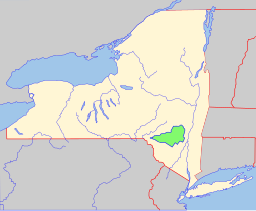Catskill State Park
| Catskill Park | |
| New York Forest Preserve | |
|
View to central Catskills from Twin Mountain
|
|
| Country | United States |
|---|---|
| State | New York |
| Region | Catskill Mountains |
| Counties | Delaware, Greene, Sullivan, Ulster |
| River | Esopus Creek, Neversink River, Rondout Creek, Schoharie Creek |
| Highest point | Slide Mountain |
| - location | Shandaken |
| - elevation | 4,180 ft (1,274 m) |
| - coordinates | 41°59′55″N 74°23′11″W / 41.99861°N 74.38639°W |
| Lowest point | Saw Kill along Blue Line N |
| - location | W of Kingston |
| - elevation | 120 ft (37 m) |
| - coordinates | 41°58′50″N 74°00′36″W / 41.98056°N 74.01000°W |
| Area | 1,120 sq mi (2,901 km2) |
| Geology | Sedimentary Devonian shale and sandstone |
| Founded | 1885 |
| Owner | New York State Department of Environmental Conservation, local governments, private landowners |
| For public | Yes |
| Visitation | 553,000 (2002) |
|
Catskill Park within New York state
|
|
|
Location of New York in the United States
|
|
The Catskill Park is in the Catskill Mountains in New York in the United States. It consists of 700,000 acres (280,000 ha; 2,800 km2) of land inside a Blue Line in four counties: Delaware, Greene, Sullivan, and Ulster. As of 2005, 287,514 acres (116,353 ha) or 41 percent of the land within, is owned by the state as part of the Forest Preserve; it is managed by the Department of Environmental Conservation (DEC). Another 5% is owned by New York City to protect four of the city's reservoirs in the region that lie partially within the park and their respective watersheds.
There are bobcats, minks and fishers in the preserve, and coyotes are often heard. There are some 400 black bears living in the region. The state operates numerous campgrounds and there are over 300 miles (500 km) of multi-use trails. Hunting is permitted, in season, in much of the park. It has approximately 50,000 permanent residents, bolstered somewhat by second-home ownership on weekends and in the summer, and attracts about half a million visitors every year.
The park is governed by Article 14 of the state constitution, which stipulates that all land owned or acquired by the state within cannot be sold or otherwise transferred (absent amending the constitution, which has been done on several occasions), may not be used for logging and must remain "forever wild."
Being the smaller and less well-known of New York's two Forest Preserves, residents of and advocates for the Park often feel that it gets neglected by the state government in Albany. A popular saying in the region is that the DEC Commissioner's chair faces north (i.e., toward the Adirondacks). In recent years DEC has been working to change that. Despite that perception, however, some key innovations in how New York manages its Forest Preserve have come from the Catskills.
...
Wikipedia



